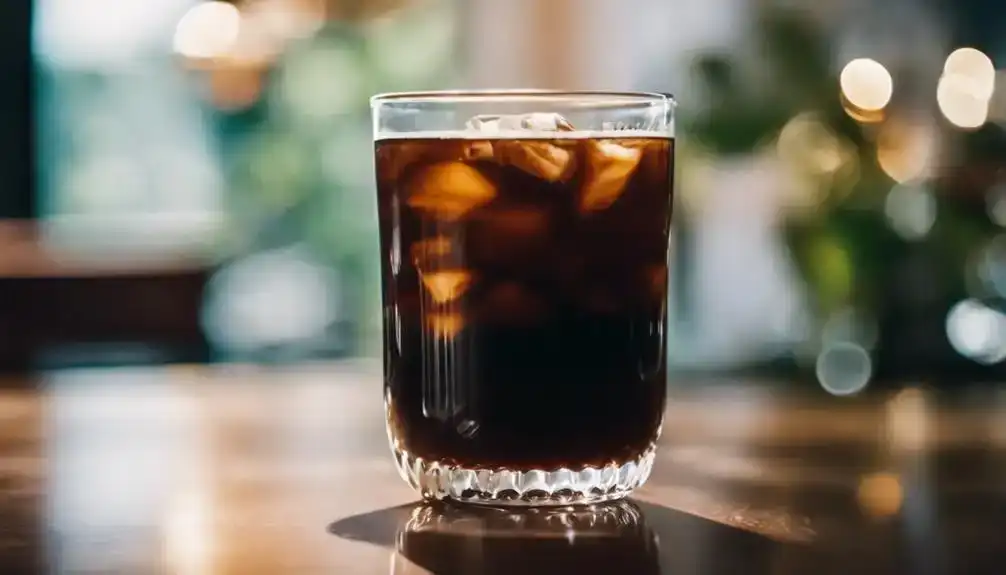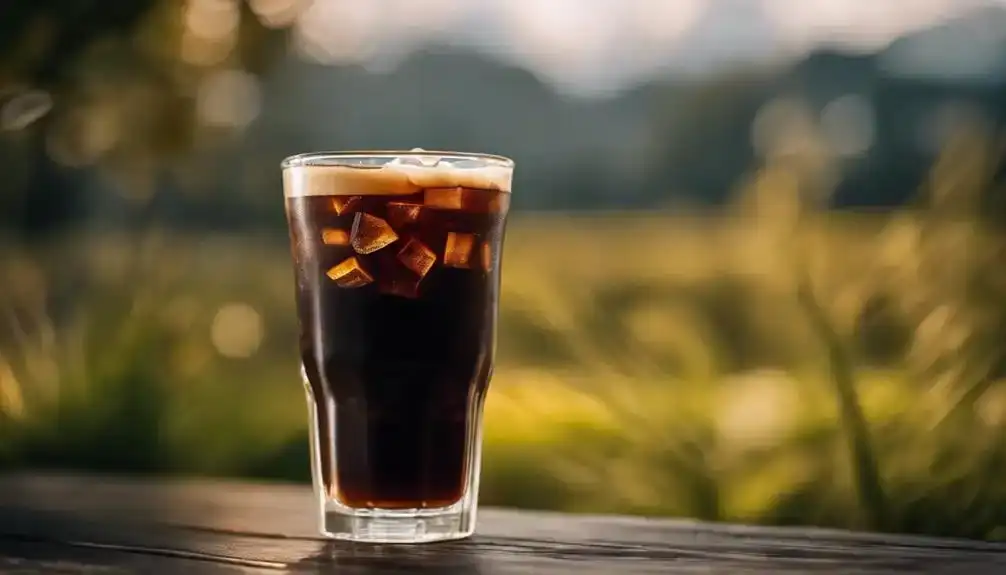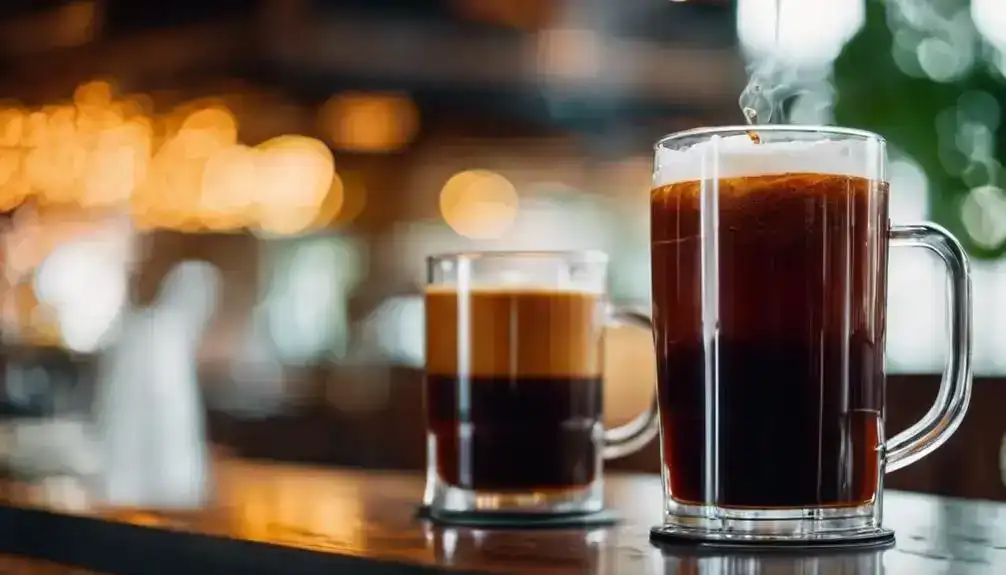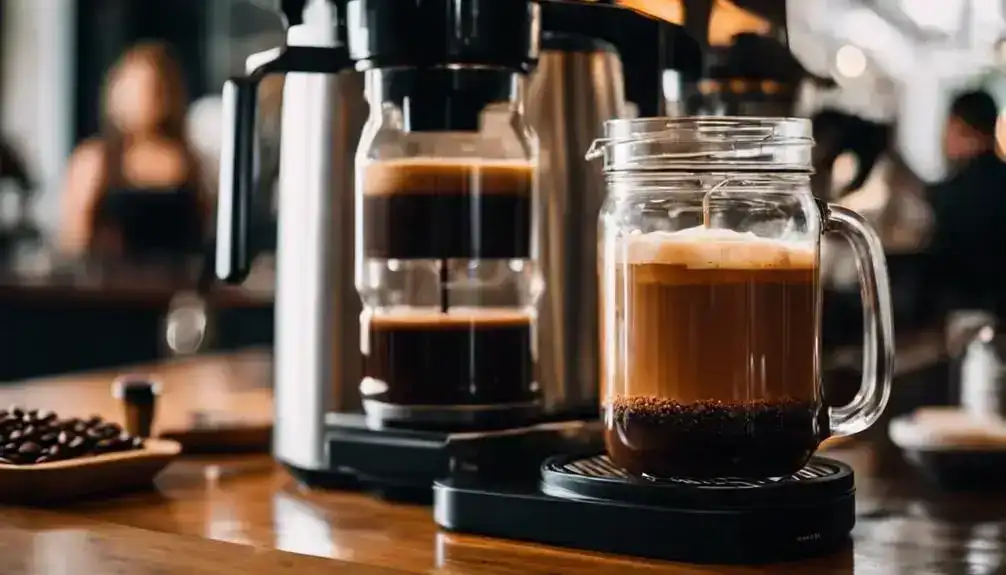Have you ever wondered if the temperature of your coffee affects its taste more than you realize? The debate between cold brew and hot brew coffee has been ongoing, with enthusiasts on both sides fiercely defending their preferred method.
But have you truly considered all the factors that come into play when choosing between the two? From flavor nuances to health impacts and even the cost analysis, there’s a lot to consider before declaring your allegiance to one over the other.
As a seasoned barista with years of experience in the coffee industry, I can provide valuable insights into the nuances of cold brew and hot brew coffee to help you make an informed decision.
Overview of Cold Brew and Hot Brew

Let’s kick off by defining what cold brew and hot brew actually are.
Exploring their roots in historical contexts.
Shedding light on the current trends surrounding these popular coffee preparation methods.
Defining the Brews
When comparing cold brew and hot brew coffee, it’s essential to understand the fundamental differences between these two brewing methods. Here’s a quick rundown to help you grasp the unique aspects of each:
- Brewing Comparison:
- Cold Brew: Steeped in cold water for an extended period.
- Hot Brew: Brewed quickly with hot water.
- Taste Preferences:
- Cold Brew: Often smoother and less acidic.
- Hot Brew: Typically bolder and more aromatic.
- Extraction Process:
- Cold Brew: Slow extraction process.
- Hot Brew: Quick extraction due to heat.
Whether you lean towards the bold flavors of hot brew or the smoother profile of cold brew, understanding these brewing differences can help you make the perfect choice based on your taste preferences.
Historical Context and Current Trends
To gain a deeper understanding of the evolution and popularity of cold brew and hot brew coffee, it’s enlightening to explore their historical roots and current trends in the coffee industry.
- Historical Evolution:
Cold brew has a rich history, dating back centuries, often linked to Japanese Kyoto-style brewing. Hot brew, on the other hand, has been a staple in various cultures for generations.
- Cultural Impact:
Cold brew has gained popularity for its smooth taste and low acidity, Appealing to a modern audience seeking new coffee experiences. Hot brew continues to be a traditional favorite, deeply ingrained in societal norms.
- Market Trends:
Cold brew has seen exponential growth in recent years, particularly among younger consumers looking for convenient, Ready-to-drink options.
- Consumer Behavior:
Hot brew still dominates the market, but the rise of specialty coffee shops has fueled interest in unique brewing methods like cold brew, catering to evolving consumer preferences.
Cold Brew vs Hot Brew: Brewing Techniques Explored

Let’s kick off by exploring the brewing techniques of both Cold Brew and Hot Brew.
Cold Brew involves Steeping coffee grounds in cold water for an extended period, resulting in a smooth, less acidic brew.
On the other hand, Hot Brew uses hot water to quickly extract flavors from the coffee grounds, producing a more robust and aromatic cup of coffee.
Cold Brew Methodology
Let’s kick off by examining the extraction process and time differences between cold brew and hot brew methods. Understanding how the temperature affects the coffee grounds during brewing is key to grasping the nuances of each method.
Additionally, we’ll explore the distinct flavor profiles that arise from the varying extraction techniques used in cold brew and hot brew processes.
Extraction Process and Time
When comparing the extraction process and time between cold brew and hot brew coffee, the differences in flavor profiles become evident. Cold brew, known for its longer extraction time and lower brewing temperature, offers a smoother, less acidic taste. In contrast, hot brew coffee, with its quicker extraction process and higher brewing temperature, yields a more robust and intense flavor profile.
| Extraction Method | Time Taken |
|---|---|
| Cold Brew | Longer |
| Hot Brew | Quicker |
Flavor Extraction Differences
Flavor extraction differences between cold brew and hot brew coffee showcase distinct taste profiles influenced by brewing techniques.
- Cold brew: Slow extraction process enhances flavor intensity.
- Hot brew: Higher brewing temperature can lead to quicker extraction.
- Cold brew: Delicate flavors due to extended steeping time.
- Hot brew: Bold flavors extracted rapidly.
- Cold brew: Lower acidity levels compared to hot brew.
Hot Brew Methodology
Let’s kick off by comparing the extraction process and time between hot brew and cold brew methods. Understanding these differences will give you insight into how each method affects the flavor extraction of your coffee.
Extraction Process and Time
The extraction process and time significantly differ between cold brew and hot brew methods in coffee preparation. Cold brew’s slow extraction over 12-24 hours yields a smoother, less acidic taste due to lower extraction efficiency. In contrast, hot brew’s quick extraction in minutes extracts more flavors, resulting in a robust, intense taste. Check out the table below for a quick comparison:
| Method | Extraction Efficiency | Flavor Intensity | Brewing Time |
|---|---|---|---|
| Cold Brew | Low | Mild | 12-24 hours |
| Hot Brew | High | Strong | Minutes |
Flavor Extraction Differences
Moving from the extraction process and time discussion, you can now explore how the brewing techniques of cold brew and hot brew coffee influence the extraction of flavors.
- Cold brew:
- Smooth flavor profiles
- Lower acidity levels
- Enhanced sweetness
- Mellow taste characteristics
- Subtle bitterness
Understanding these differences can help you choose the coffee that best suits your taste preferences and desired flavor experience.
Flavor Profiles: Cold Brew vs. Hot Brew

When comparing the flavor profiles of cold brew and hot brew, you’ll notice distinct taste characteristics in each. Cold brew tends to be smoother and less acidic, showcasing subtle nuances of the coffee beans.
On the other hand, hot brew often highlights brighter and more pronounced flavors, with a fuller body that some coffee enthusiasts prefer.
Taste Characteristics of Cold Brew
Indulging in a sip of cold brew unveils a smooth and subtly sweet flavor profile that sets it apart from its hot brewed counterpart. When comparing the taste characteristics of cold brew to hot brew, here are some key points to consider:
- Less Acidity: Cold brew tends to be less acidic, offering a smoother drinking experience.
- Enhanced Sweetness: The slow brewing process of cold brew enhances its natural sweetness.
- Subtle Bitterness: Cold brew often has a milder bitterness compared to hot brew.
- Full-bodied Flavor: Despite its smoothness, cold brew maintains a full-bodied flavor profile.
- Refreshing Finish: The cold brewing method results in a Refreshing and crisp finish that’s perfect for warm days.
Taste Characteristics of Hot Brew
For those seeking a more robust and intense coffee experience, hot brew offers a distinct flavor profile that sets it apart from its cold brew counterpart. When it comes to taste characteristics, hot brew coffee boasts the following attributes:
- Rich and full-bodied flavor that can be more pronounced than cold brew.
- Higher acidity levels, providing a tangy and bright taste.
- Enhanced aroma that fills the room with enticing coffee scents.
- Quick extraction process that captures the essence of the beans.
- Higher caffeine content, delivering a potent kick to jumpstart your day.
Hot brew’s flavor profile is a dynamic symphony of flavors that cater to those who crave a bold and invigorating coffee experience.
Caffeine Content and Health Impacts

When it comes to caffeine content and its effects on health, comparing cold brew and hot brew coffee can offer valuable insights. Understanding the differences in caffeine levels, acidity, and their impact on digestive health is essential for making informed choices about your coffee consumption.
Exploring these aspects will help you determine which type of coffee best suits your preferences and lifestyle.
Comparing Caffeine Levels
Comparing the caffeine levels in cold brew and hot brew coffee can provide insights into their respective caffeine content and potential health impacts. Cold brew coffee often has a higher caffeine concentration per ounce than hot brew due to its extended steeping time. This can lead to a more potent caffeine kick per serving. However, hot brew coffee is usually consumed in larger quantities, balancing out the overall caffeine intake. Caffeine, in moderation, can offer health benefits like increased focus and alertness. To help you better understand the caffeine content in each type of coffee, here is a comparison table:
| Coffee Type | Caffeine Content (per 8 oz) |
|---|---|
| Cold Brew | 100-200 mg |
| Hot Brew | 70-140 mg |
Acidity and Digestive Health
To understand the effects of caffeine content on acidity and digestive health, consider the impact cold brew and hot brew coffee may have on your stomach’s well-being. When it comes to acidic balance and gut health, the brewing method can play a significant role. Here are some key points to keep in mind:
- Cold brew coffee tends to be less acidic than hot brew, which can be gentler on your stomach.
- Hot brew coffee may stimulate the production of digestive enzymes, aiding in digestion.
Acidity levels in coffee can vary based on factors like bean origin and roasting process. Monitoring your caffeine intake can help maintain a healthy digestive system. Experimenting with both cold brew and hot brew can help you find what works best for your individual digestive health needs.
Cold Brew vs Hot Brew: Preparation and Customization
When preparing cold brew, you’ll be steeping coffee grounds in cold water for an extended period.
Hot brew, on the other hand, involves quickly extracting flavors through hot water.
The customization options vary between the two methods, offering different taste profiles to suit your preference.
Techniques for Cold Brew
When making cold brew, you’ll need specific tools and ingredients like a large jar, coffee grounds, and water.
Additionally, customization options for cold brew include adding flavors like vanilla, cinnamon, or even experimenting with different types of coffee beans.
Get ready to elevate your cold brew experience by exploring these techniques and making a personalized cup of coffee that suits your taste preferences.
Required Tools and Ingredients
You’ll need specific tools and ingredients to prepare both cold brew and hot brew coffee effectively.
- Coffee grinder for freshly ground beans
- Quality coffee beans for rich flavor
- Filtered water for a clean taste
- Brewing equipment like a French press or drip coffee maker
- Measuring spoons for precise coffee-to-water ratios.
Customization Options
For enhanced flavor and personal preference, consider incorporating various customization options into your cold brew or hot brew coffee preparation.
- Flavor Enhancements: Experiment with adding spices like cinnamon or nutmeg.
- Brewing Variations: Try different brewing times for unique tastes.
- Infusions: Infuse your coffee with flavors like vanilla or lavender.
- Sweeteners: Explore using alternative sweeteners such as honey or maple syrup.
- Milk Alternatives: Swap traditional milk for options like almond or oat milk.
Techniques for Hot Brew
When making hot brew coffee, ensure you have the necessary tools and ingredients ready for a successful brewing session.
Experiment with various customization options to tailor your coffee to your taste preferences and discover new flavor profiles.
Get creative with your hot brew techniques to elevate your coffee experience and enjoy a delicious cup brewed just the way you like it.
Required Tools and Ingredients
To prepare both cold brew and hot brew coffee effectively, gather the essential tools and ingredients needed for each method.
- For Cold Brew:
- Coarse ground coffee beans
- Filtered water
- Mason jar or cold brew maker
- Fine mesh strainer
- Paper coffee filters
Ensure you have these items to craft a delightful cold brew with unique flavor profiles.
Customization Options
Considering your preferences and desired flavor profiles, you can easily customize both cold brew and hot brew coffee to suit your tastes and enjoy a personalized brewing experience.
- Experiment with unique flavor combinations like cardamom-infused syrup or lavender essence.
- Try different brewing methods such as pour-over or French press for a distinct taste.
- Explore adding spices like cinnamon or nutmeg to your coffee grounds.
- Mix in flavored creamers or syrups for a sweet twist.
- Adjust the strength and acidity levels by altering the brewing time and temperature.
Cold Brew vs Hot Brew: Cost Analysis

When comparing Cold Brew and Hot Brew in terms of cost, consider factors like the cost of preparation and the price points in retail. Understanding these aspects can help you determine which brewing method fits your budget and preferences.
Let’s explore how these financial considerations play a role in your coffee choices.
Cost of Preparation: Cold Brew vs. Hot Brew
Comparing the cost of preparing cold brew and hot brew coffee reveals significant differences in expenses. When considering cost efficiency, Cold brew may initially seem more expensive due to the larger amount of coffee grounds required, but in the long run, it can be more economical as it can be stored for a longer time. On the other hand, hot brew requires less coffee but might entail additional costs like filters and electricity. Let’s break it down further in the table below:
| Cost Category | Cold Brew | Hot Brew |
|---|---|---|
| Coffee Grounds | $$ | $$ |
| Filters | $ | $$ |
| Electricity | $ | $$ |
Price Points in Retail
Wondering how the price points for cold brew and hot brew compare in retail settings? When it comes to retail pricing trends, the cost of a cup of cold brew coffee tends to be slightly higher than hot brew due to the longer brewing process and increased demand for this trendy beverage. Market competition dynamics also play a role, with some coffee shops leveraging the popularity of cold brew to justify a premium price. Check out the table below for a quick comparison of the average prices you might encounter:
| Coffee Type | Price Range | Average Price |
|---|---|---|
| Hot Brew | $2.50 – $4.00 | $3.25 |
| Cold Brew | $3.00 – $4.50 | $3.75 |
Next, we’ll delve into the factors influencing these price points.
Consumer Preferences and Seasonality

When it comes to your coffee choices, seasonal consumption patterns can greatly influence your preferences. Understanding demographic trends can also shed light on why certain groups prefer cold brew over hot brew or vice versa.
Consider how your own taste buds might change based on the time of year.
Seasonal Consumption Patterns
During the summer months, coffee drinkers tend to favor cold brew over hot brew due to its refreshing and smooth qualities. When considering seasonal trends and consumption habits, it’s interesting to note how preferences shift with the weather. In the warmer months, cold brew gains popularity for its chilled and invigorating nature. Here are five key points to consider:
- Cold brew’s lower acidity makes it a gentler option for sensitive stomachs.
- The slow steeping process of cold brew enhances the natural flavors of the coffee beans.
- Cold brew can be easily customized with various syrups and milk alternatives for a personalized touch.
- Its convenience in being prepared in advance makes it a go-to option for busy mornings.
- The cold brew trend continues to evolve with New brewing methods and flavor infusions.
Demographic Trends and Preferences
Considering consumer preferences and seasonality, various demographic trends shed light on the popularity of cold brew versus hot brew among different age groups.
- Consumer Behavior: Younger consumers tend to prefer the smooth and less acidic taste of cold brew, while older generations often stick to traditional hot brew for its comforting familiarity.
- Purchasing Habits: Millennials and Gen Z are more likely to try new coffee trends, leading to a surge in cold brew sales, whereas Gen X and Baby Boomers typically opt for hot brew during their regular coffee runs.
- Cultural Influences: In regions with warmer climates, cold brew gains traction due to its refreshing nature, while colder regions see a continued preference for hot brew to combat chilly weather.
- Regional Preferences: Coastal areas and urban centers often embrace cold brew as a trendy beverage, whereas rural communities and inland regions may lean towards the classic appeal of hot brew.
- Innovation: As the coffee industry evolves, understanding these demographic nuances can help coffee brands tailor their offerings to suit the diverse preferences of consumers across different age groups and regions.
Conclusion
In the battle of cold brew vs hot brew, both have their strengths and weaknesses.
Cold brew offers a smooth and refreshing taste, perfect for hot summer days. Hot brew provides a bold and aromatic experience, ideal for chilly mornings.
While both have their loyal fans, cold brew wins the hearts of many with its icy charm and irresistible allure.
So next time you’re faced with the choice, let your taste buds decide which coffee reigns supreme in your world.

